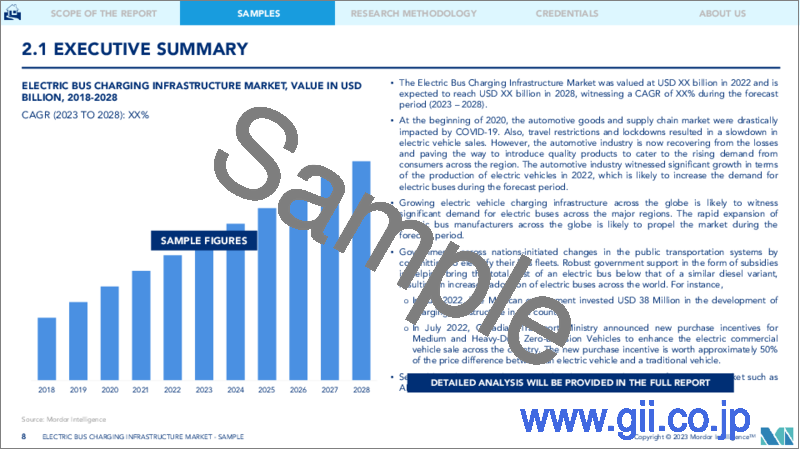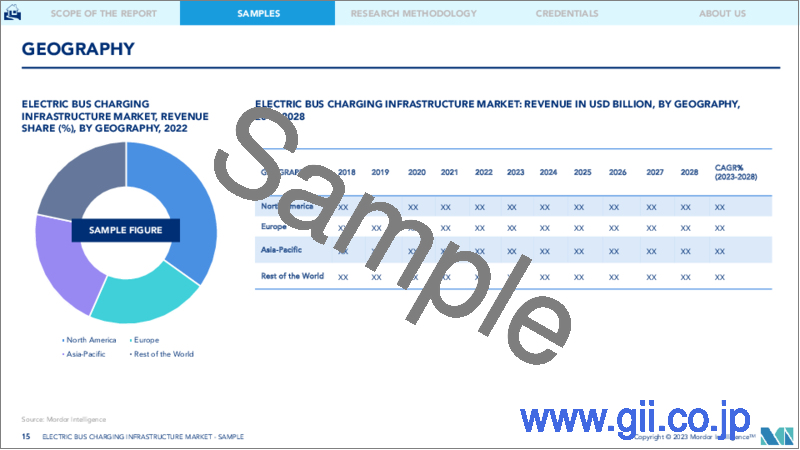|
|
市場調査レポート
商品コード
1137918
電気バス充電インフラ市場- 成長、動向、予測(2022年-2027年)Electric Bus Charging Infrastructure Market - Growth, Trends, and Forecasts (2022 - 2027) |
||||||
|
● お客様のご希望に応じて、既存データの加工や未掲載情報(例:国別セグメント)の追加などの対応が可能です。 詳細はお問い合わせください。 |
|||||||
| 電気バス充電インフラ市場- 成長、動向、予測(2022年-2027年) |
|
出版日: 2022年10月13日
発行: Mordor Intelligence
ページ情報: 英文 100 Pages
納期: 2~3営業日
|
- 全表示
- 概要
- 目次
電気バス充電インフラ市場は、2021年に16億8000万米ドルと評価され、2027年には66億3000万米ドルに達し、予測期間(2022-2027年)に約16.4%のCAGRで推移すると予測されています。
コロナウイルスの流行中、数多くの変数が世界の電気バス充電インフラ市場に影響を及ぼしています。この業界は、他の多くの業界と同様に、流行の結果、大幅な景気後退に見舞われました。市場の成長に影響を与える重要な変数は、サプライチェーンの制約と「EVバッテリーの需要減」です。市場は、電池製造に必要な最も重要な部品の供給不足によって深刻な影響を受けています。しかし、コロナウイルス感染の減少によりサプライチェーンの制約が緩和されると、業界の大手企業は、5Gなどの最先端技術を取り入れることで市場成長を後押しするための研究開発に着手しています。
長期的には、より厳しい公害規制の世界の導入により、予測期間を通じて電気自動車の販売が増加すると予想されます。EVの需要拡大に対応するため、自動車用パワーモジュールのメーカーは、自動車の販売と輸出が世界一であり、ASEAN諸国の中でEV部品の関税が最も低いアジア太平洋地域を中心に、生産能力拡大のための投資を始めています。
主なハイライト
- 2022年9月、インド道路交通高速道路省が国道5000kmに電気自動車充電スタンドを整備するパイロットプロジェクトが、2022年9月9日からデリー-ジャイプル線で電気バスによる技術・商業試験の最終段階に入っています。これにより、2021年に先に実施されたデリー-アグラ間の210kmの試験走行に278kmが加わり、試験段階の4州にわたる合計500マイルの技術試験が完了することになります。UP州、デリー州、ハリヤナ州、ラジャスタン州の4州で合計500マイルの技術試験が完了します。
中国と米国は、電気バスの高い導入率を記録しました。今後数年間、上記の国々は、政府、交通機関、その他のグリーンビークルを支援するコミュニティや組織からの強い後押しを受けて、より多くの電気バスを配備し続けると予想されます。
主な市場動向
電気バスの普及に向けた政府の取り組み
現在、交通機関の排ガスを削減するための技術として、E-モビリティが最も有望視されています。電気バスは、従来のディーゼルエンジンバスに代わって、バッテリー駆動の自動車の普及を上回るペースで加速度的に普及しています。ブルームバーグ・ニュー・エネルギー・ファイナンスの予測によると、2030年までに自動車販売の28%が電気自動車になり、新しいバスの84%が電気バスになると言われています。
電気バス市場は、主要国の公共交通機関の脱炭素化を推進する政府によって、世界中で急成長しています。多くの国で、電気バスの調達目標が設定されています。例えば
ジョー・バイデン政権は、米国をゼロ・エミッション交通に移行させることを目的に、電気自動車の導入を促進する1740億米ドルのプログラムを提案しています。新興の大型電気バス分野における主要市場プレイヤーの技術革新は、メンテナンスコストと効率の低下により、電気バスの市場成長を後押ししています。
中国の電気自動車への動きは今後も続くと予想され、2025年までに42万台の新しい電気バスが購入される見込みです。市場の拡大と政府の支援により、電気バスの保有台数は大幅に(約40%)増加することができるはずです。
インドでは2030年までに、バスの40%を含む商用車の70%を電気自動車として販売したいとしており、炭素排出のネットゼロを達成するという目標もこれに沿ったものです。
欧州では、2021年の電気バスの登録台数は2020年に比べて48%上昇しました。昨年は3,282台のeバスが納車され、2012年以降、大陸での登録台数は8,500台以上に増加しました。欧州政府は、主に電気自動車の販売目標を達成するために、さまざまな政策を策定し、地域全体で充電インフラの構築のためのプロジェクトを開始しています。
欧州全体の温室効果ガス排出量の約27%を占める運輸部門は、NOxなど他の危険な排出物の発生源にもなっています。現在、欧州では、あらゆるタイプのパワートレイン(電気・非電気)を含む約72万5千台のバスが運行されています。このうち電気バスは約2,500台で、大半はディーゼルで走っていることが分かります。欧州連合が2019年2月に採択した新ルールでは、2025年までに公共機関は新車の4分の1の「クリーン」バスを購入しなければなりません。2030年からはその比率が3分の1に上昇します。その結果、欧州の都市では今後、バス路線が大幅に拡大します。「C40 Declaration for fossil-free streets」にはパリ、ベルリン、ロンドン、コペンハーゲン、バルセロナ、ローマ、ロッテルダムなど40都市が同時に署名し、2025年までにゼロ・エミッションバス車両を目標に掲げているのです。
電気バス充電インフラ市場をリードするアジア太平洋地域
アジア太平洋地域の電気バス充電インフラ市場は、中国がリードしており、次いで欧州、北米がそれぞれリードしています。現在、運行されている電気バスの99%は中国にあります。これは、中国の都市で大気汚染の問題が大きく、地元当局が排出しない輸送手段に投資することを決定したためです。インドのような他の新興諸国は、国内でより多くの電気バスを採用することで、電気バス充電インフラ市場に燃料を供給しています。
中国は、世界の電気バス市場の主要なプレーヤーであり、世界の電気バスの98%を所有しています。中国は予測期間中、その優位性を維持すると予想されます。2021年3月には、421,000台以上の電気バスが中国で使用されており、これは世界のフリートの約99.0%に相当します。公共交通機関の電化に熱心に取り組み、補助金や国の規制が普及していることが、世界の電気バス市場における中国の高い市場シェアにつながる大きな要因となっています。
中国の交通運輸省は、低排出ガスバスの市場開拓のために補助金やその他の利益を提供しており、それがさらに市場にプラスの影響を与えています。例えば、2020年の間に中国のバスメーカーが販売した新エネルギーバスは、パンデミックにもかかわらず、61,000台増加しました。
中国の電気バスの拡大は今後も続き、2025年までに42万台の電気バスが追加発注されると予想されます。市場の成長と政府の支援により、電気バスの保有台数も約40%と大幅に増加するはずです。
深センと広州は完全な電気バスの導入でリードしている都市であり、今後数年でさらに多くの中国都市がこれに続くと予想されます。珠江デルタの広州、珠海、東莞、仏山、中山、南京、杭州、陝西、山東など、30以上の都市が2021年の開始までに公共交通機関の100%電化を達成する計画を立てており、予測期間中、中国は引き続き電気バスの導入が拡大する可能性があります。
中国はバッテリー式電気バスに重点を置いているが、長距離走行が可能なハイブリッドバスもかなりの台数走っています。予測期間中、シリーズハイブリッドがハイブリッドバスの主要なシェアを占めると予想されます。このタイプのパワートレインは設計と組み立てが容易で、電気バスの総コストを削減できるため、より多くのバスがこのタイプのパワートレインを装備すると予想されます。
その他の重要な国としては、インドが挙げられます。しかし、インドでは、電気バスやハイブリッドバスの普及は遅れており、その主な理由はコスト面です。ハイブリッドバスや電気バスの平均コストは、ディーゼルバスの3~4倍です。さらに,ディーゼルのコストが低下しているため,事業者がハイブリッドバスや電気バスに移行するインセンティブがあまりないのが現状です。デリーやムンバイのように、バスの運行にCNGなどのクリーン燃料を使用している都市もあります。
そこでインド政府は、事業者に電気バスを採用させるため、自動車部門の電気・ハイブリッド部品の成長を加速させる「National Electric Mobility Mission Plan(NEMMP)2020」を発表しました。この計画は、主にインドにおける電気自動車の製造とイントロダクションの迅速な推進に重点を置いています。例えば
- 2022年9月、インドでは、5つの州政府に代わり、CESL-Convergence Energy Services Ltd.(以下、CESL社。(EESL-Energy Efficiency Services Ltd.の子会社)は、5,450台の電気バスの契約を付与しています。CESLは、インドの公害を削減し、電気バスメーカーを後押しするために、NITI Ayogによって認可された50,000台の電気バスの入札を100億米ドル(8万ルピー)で行う予定です。
競合情勢
電気バス充電インフラ市場は、ABBグループ、Proterra Inc.(電気バスメーカーでもある)、ChargePoint Inc.、Siemens AG、その他といった少数のプレーヤーによって統合され、主導されています。各社は、ブランドポートフォリオを拡大するために、戦略的パートナーシップ、買収、製品開発に参入しています。
- 2021年11月、The California Energy Commissionは、Los Angeles Department of Transportation(LADOT)に対し、太陽光と蓄電のマイクログリッドを利用した米国最大級のEVフリート充電システムの設置に600万米ドルの補助金を交付しました。LADOTは、ワシントン・バス・ヤードに、1.5メガワットの屋上およびバス用ソーラーキャノピーと組み合わせて、4.5メガワットのApparentエネルギー貯蔵システムを設置し、プロテラの1.5メガワットのフリートチャージャー5基と104台のリモートEV充電ディスペンサーに電力を供給する予定です。
その他の特典
- エクセル形式の市場予測(ME)シート
- アナリストによる3ヶ月間のサポート
目次
第1章 イントロダクション
- 調査の前提条件
- 調査範囲
第2章 調査手法
第3章 エグゼクティブサマリー
第4章 市場の力学
- 市場促進要因
- 市場抑制要因
- 産業の魅力- ポーターのファイブフォース分析
- 新規参入業者の脅威
- 買い手/消費者の交渉力
- 供給企業の交渉力
- 代替品の脅威
- 競争企業間の敵対関係
第5章 市場のセグメンテーション
- 充電タイプ
- プラグイン充電
- オーバーヘッド充電
- 地域別
- 北米
- 欧州
- アジア太平洋地域
- 世界のその他の地域
第6章 競合情勢
- ベンダーの市場シェア
- 企業プロファイル
- Electric Charging Infrastructure Suppliers
- ABB Ltd
- Proterra Inc.(also electric bus manufacturer)
- ChargePoint Inc.
- Siemens AG
- Electric Bus Manufacturers
- BYD Auto Co. Ltd
- Daimler AG
- Electric Charging Infrastructure Suppliers
第7章 市場機会と今後の動向
The electric bus charging infrastructure market was valued at USD 1.68 Billion in 2021, and it is expected to reach USD 6.63 Billion by 2027, registering a CAGR of around 16.4% during the forecast period (2022-2027).
During the coronavirus epidemic, numerous variables are influencing the worldwide electric bus charging infrastructure market. This industry, like most others, has suffered a significant downturn as a result of the epidemic. The key variables influencing the market growth are supply chain constraints and 'falling demand for EV batteries.' The market is being severely impacted by the lack of availability of the most significant components for battery manufacture. However, when supply chain constraints are relaxed due to fewer coronavirus infections, the industry's leading players have begun research and development to boost market growth by incorporating cutting-edge technologies like 5G.
Over the long term, the global adoption of stricter pollution regulations is expected to boost electric car sales throughout the projection period. To meet the growing demand for EVs, manufacturers of automotive power modules have begun investing in expanding their production capacities, primarily in the Asia-Pacific region, which has the world's highest sales and export of vehicles, as well as the lowest tariff on EV parts among ASEAN countries.
Key Highlights
- In September 2022, A pilot project, through which the Ministry of Road Transport & Highways in India, is developing EV charging stations across 5000km of the national highway, is presently in its last stages of technical and commercial testing using electric buses on the Delhi-Jaipur line beginning September 9th, 2022. This will add a 278 km length to the previously performed 210 km trial run between Delhi and Agra in 2021, completing technical testing of a total of 500 miles across four states in its pilot phase: UP, Delhi, Haryana, and Rajasthan.
China and the United States registered higher adoption of electric buses. In the coming years, the above countries are expected to continue to deploy more electric buses, owing to strong encouragement from the governments, transit agencies, as well as other green vehicle-supporting communities and organizations.
Key Market Trends
Governmental Efforts to Increase in the Number of Electric Buses
E-mobility is currently seen as the most promising technology to reduce exhaust emissions in transportation. Electric buses are replacing conventional diesel-fueled buses at an accelerating rate that is outpacing the adoption of battery-powered cars. According to forecasts by Bloomberg New Energy Finance, by 2030, ~28% of car sales are likely to be electric vehicles, while 84% of new buses will be electric buses.
The electric bus market is rapidly growing across the world owing to the governmental push to decarbonize public transportation in major countries. Many countries have established goals to procure electric buses. For instance,
The Joe Biden administration has proposed a USD174 billion program to promote the adoption of electric vehicles with the goal of moving the United States toward zero-emission transportation. The major market players' innovation in the emerging heavy-duty electric bus sector is boosting the market growth of e-buses by lowering their maintenance costs and efficiency.
China's move toward electric vehicles is expected to continue, with 420,000 new electric buses expected to be purchased by 2025.Electric bus fleets should be able to grow significantly (about 40%) as a result of market expansion and government support.
By 2030, India wants to sell 70% of all commercial vehicles, including 40% of buses, as electric vehicles.The objective of achieving net zero carbon emissions is in line with this.
In Europe, electric bus registrations climbed by 48% in 2021 compared to 2020. Last year, 3,282 e-buses were delivered, increasing the total number of vehicles registered on the continent to over 8,500 since 2012. The European government has formulated various policies and has started projects for building the charging infrastructure across the region, primarily to meet the electric vehicle sales target.
The transportation sector, which contributes about 27% to Europe's total greenhouse emissions, is also a source of other dangerous emissions, like NOx. At present, approximately 725,000 buses operate in Europe, including all types of powertrains (electric and non-electric). Out of these, around 2,500 are electric buses, which indicates that the majority of them run on diesel. By 2025, public agencies must purchase "clean" buses for a quarter of all new buses under the new rules that the European Union adopted in February 2019.from 2030, the ratio will rise to one third.As a result, bus lines will expand significantly in European cities in the coming years.The C40 Declaration for fossil-free streets has been signed simultaneously by 40 cities, including Paris, Berlin, London, Copenhagen, Barcelona, Rome, and Rotterdam, with the goal of zero-emission bus fleets by 2025.
Asia Pacific is Leading the Electric Bus Charging Infrastructure Market
The electric bus charging infrastructure market in the Asia Pacific is led by China, followed by Europe and North America, respectively. Currently, 99% of electric buses in service are in China, due to the major air pollution problems in Chinese cities and the decision of local authorities to invest in transport that does not emit. Other developing countries like India are fueling the electric bus charging infrastructure market by adopting more electric buses in the country.
China is a key player in the global electric bus market and is home to 98% of the world's electric buses. China is anticipated to sustain its dominance during the forecast period. In March 2021, more than 421,000 electric buses were in use China, which amounts to about 99.0% of the global fleet. The keen focus on electrification of public transit with prevalent subsidies and national regulations is a major factor contributing toward the high market share of China in the global electric bus market.
China's Ministry of Transport is offering subsidies and other benefits for the development of low emission bus fleets, thereby, further positively influencing the market. For instance, 61,000 more new energy buses were sold by Chinese bus makers during 2020, despite of the pandemic.
China's electric bus expansion is expected to continue, with 420,000 additional electric buses ordered by 2025. Growth in the market and government support should also allow for a large increase in the number of electric bus fleets, which is approximately 40%.
Shenzhen and Guangzhou are leading cities in fully electric bus fleets, while more Chinese cities are expected to follow the same in coming years. During the forecast period, China may continue to witness growth in the adoption of electric buses, as more than 30 Chinese cities have made plans to achieve 100% electrified public transit by the start of 2021, including Guangzhou, Zhuhai, Dongguan, Foshan, and Zhongshan in the Pearl River Delta, along with Nanjing, Hangzhou, Shaanxi, and Shandong.
Although China is more focused on battery electric buses, there are significant number of hybrid buses in the country owing to the long-range possibilities offered by them. During the forecast period, series hybrid category is expected to account major share in hybrid bus category. Due to the ease in designing and assembling this type of powertrain, which reduces the overall cost of electric bus, more number od buses are expected to equip this type of powertrain.
Other important countries include India . However, in India, the acceptance of electric and hybrid buses is slow, primarily due to the cost factor. The average cost of hybrid or electric buses is 3-4 times higher than diesel buses. Furthermore, with the decrease in the cost of diesel, there is not much incentive for the operators to shift to hybrid or electric buses. Some cities, like Delhi and Mumbai, are using clean fuel, like CNG, for bus operations.
Thus, to make operators adopt electric buses, the Government of India unveiled the National Electric Mobility Mission Plan (NEMMP) 2020 to accelerate the growth of the electric and hybrid components of the automotive sector. It focuses primarily on fast-tracking the manufacturing and introduction of EVs in India. For instance,
- In September 2022, In India, on behalf of five state governments, CESL-Convergence Energy Services Ltd. (a subsidiary of EESL- Energy Efficiency Services Ltd.) granted a contract for 5,450 electric buses. CESL plans to conduct a $10 billion (Rs.80,000 crore) tender for 50,000 electric buses, which has been authorized by NITI Ayog to reduce pollution in India and boost E-Bus manufacturers.
Competitive Landscape
The electric bus charging infrastructure market is consolidated and led by a few players, such as ABB Group, Proterra Inc. (also an electric bus manufacturer), ChargePoint Inc., Siemens AG, and Others. The companies are entering strategic partnerships, acquisitions, and product development to expand their brand portfolio.
- In November 2021, The California Energy Commission has given the Los Angeles Department of Transportation (LADOT) a USD 6 million grant to install one of the largest EV fleet charging systems in the United States that will be powered by a solar and storage microgrid. At the Washington Bus Yard, LADOT will install a 4.5MWh Apparent energy storage system in conjunction with 1.5 megawatts of rooftop and bus solar canopy to power five Proterra 1.5 megawatt fleet chargers with 104 remote EV charging dispensers.
Additional Benefits:
- The market estimate (ME) sheet in Excel format
- 3 months of analyst support
TABLE OF CONTENTS
1 INTRODUCTION
- 1.1 Study Assumptions
- 1.2 Scope of the Study
2 RESEARCH METHODOLOGY
3 EXECUTIVE SUMMARY
4 MARKET DYNAMICS
- 4.1 Market Drivers
- 4.2 Market Restraints
- 4.3 Industry Attractiveness - Porter's Five Forces Analysis
- 4.3.1 Threat of New Entrants
- 4.3.2 Bargaining Power of Buyers/Consumers
- 4.3.3 Bargaining Power of Suppliers
- 4.3.4 Threat of Substitute Products
- 4.3.5 Intensity of Competitive Rivalry
5 MARKET SEGMENTATION
- 5.1 Charging Type
- 5.1.1 Plug-in Charging
- 5.1.2 Overhead Charging
- 5.2 Geography
- 5.2.1 North America
- 5.2.2 Europe
- 5.2.3 Asia-Pacific
- 5.2.4 Rest of the World
6 COMPETITIVE LANDSCAPE
- 6.1 Vendor Market Share
- 6.2 Company Profiles
- 6.2.1 Electric Charging Infrastructure Suppliers
- 6.2.1.1 ABB Ltd
- 6.2.1.2 Proterra Inc. (also electric bus manufacturer)
- 6.2.1.3 ChargePoint Inc.
- 6.2.1.4 Siemens AG
- 6.2.2 Electric Bus Manufacturers
- 6.2.2.1 BYD Auto Co. Ltd
- 6.2.2.2 Daimler AG
- 6.2.1 Electric Charging Infrastructure Suppliers




